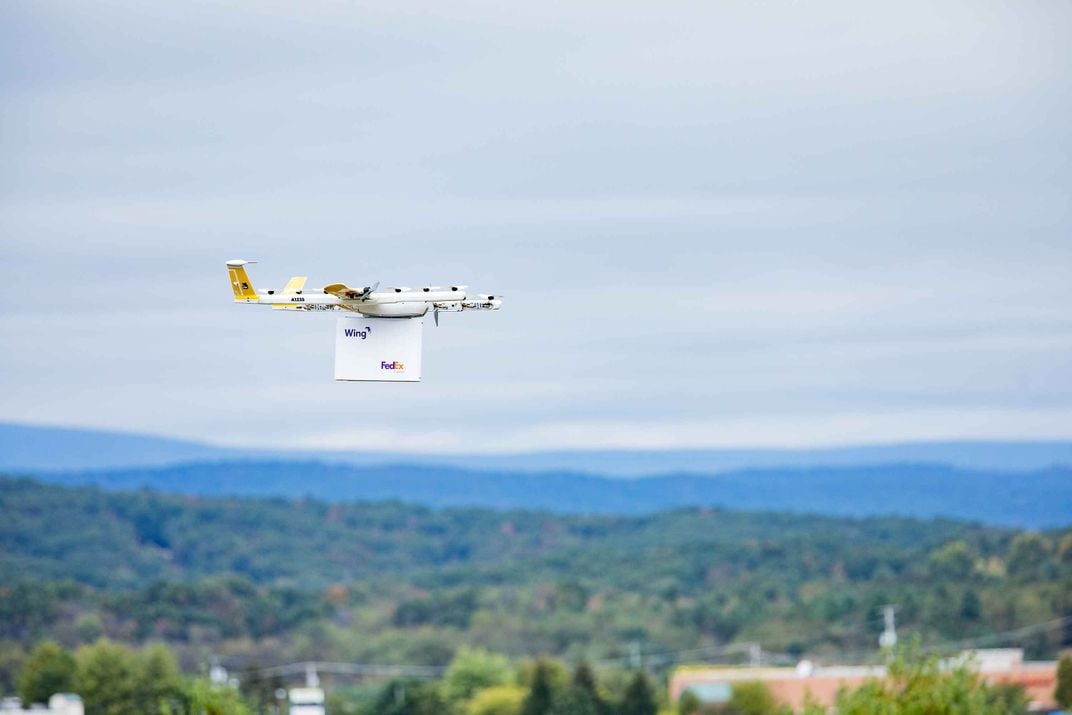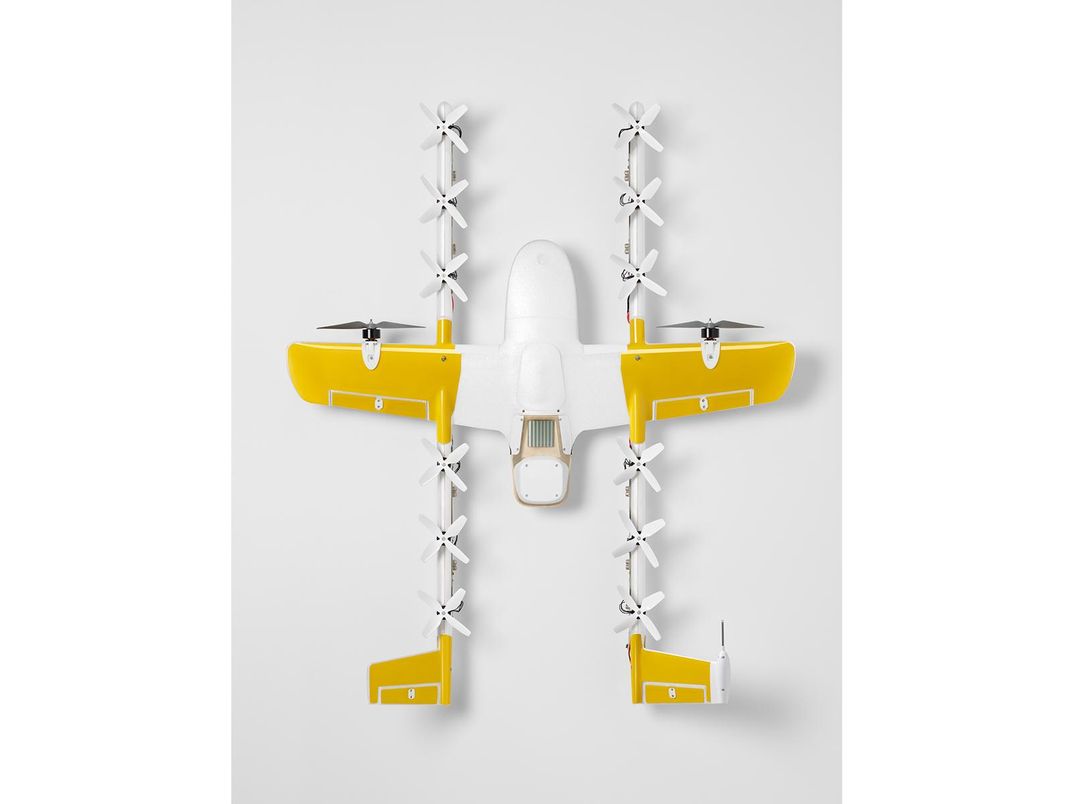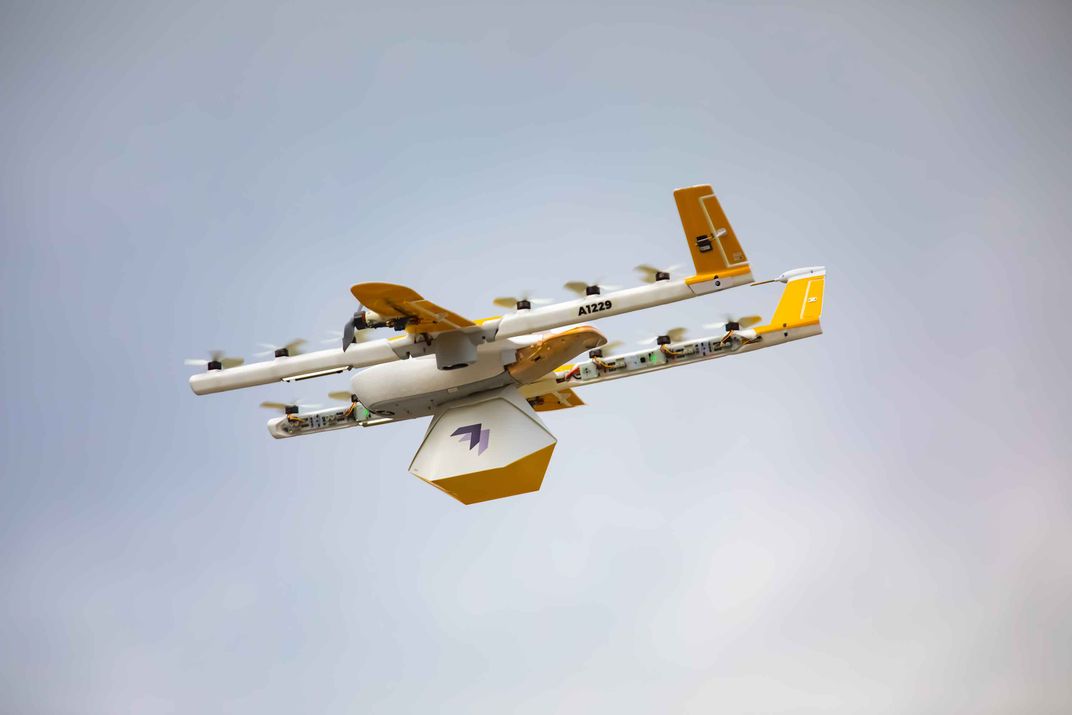This Drone Made the First Home Delivery in the United States
Wing’s tether-toting drone delivered a winter vest to a retiree in Virginia and now its headed to the Air and Space Museum
/https://tf-cmsv2-smithsonianmag-media.s3.amazonaws.com/filer/d9/cf/d9cfdd86-6da2-4486-b010-2206672ac34e/google-arts-and-culture-01_wings-history.jpg)
On October 19, 2019 a hook made of yellow plastic gently lowered a cardboard parcel onto a lawn in western Virginia. At the other end of the tether, some 23 feet overhead buzzed drone A1229. When the package touched down the yellow hook released and ascended back into the sky, sending A1229 speeding off at more than 60 miles per hour, having completed the first-ever commercial drone delivery to a home in the United States.
Inside the package was a purple winter vest ordered online by Susie Sensmeier. At the time, the novel transit of the 81-year-old retiree's new vest seemed more like a milestone in modern convenience. But since that first delivery, the global pandemic has transformed deliveries by drone from a high-tech amenity into something that provides Sensmeier and her husband Paul with added safety. As the coronavirus continues to fester across the United States, the couple has taken advantage of their city’s status as a testing ground for drone delivery company Wing to limit their contact with the outside world.
Drones designed and built by Wing, a subsidiary of Google’s parent company Alphabet, have been delivering everything from coffee to over-the-counter medications and even library books to residents of Christiansburg, Virginia, since Sensmeier’s vest launched the company’s test program in fall 2019.
Wing, which also has test programs running in Finland and Australia, says that requests for its services surged amid the pandemic. “In the first two weeks of April, we had more than 1,000 deliveries and then later we saw just as many in seven days,” says Alexa Dennett, Wing’s head of marketing and communications. Jacob Demmitt, a spokesperson for Wing based in Christiansburg, says the town’s coffee shop, Mockingbird Cafe, told the company that during the April lockdown Wing accounted for about 25 percent of their sales.

“Ten years ago I had no rational reason to expect drone technology to have advanced to where it is now, and Wing is really the next phase of that,” says Roger Connor, curator of vertical flight for the Smithsonian’s National Air and Space Museum. “Not only is Wing’s aircraft actually making residential deliveries, but they’re figuring out how the technology fits in with the local economy and society.”
Today, the Air and Space Museum announced that A1229, which edged out two other Wing drones racing to make the first official U.S. home delivery, will be added to the national collection. A1229 spent just 2 minutes and 50 seconds zooming to its destination and its historic flight covered a roundtrip distance of 2.3 miles. The drone will join other firsts in drone tech, such as the first drone to save a human life.
“I’ve been keeping an eye on Wing for a long time, but coronavirus has brought the desirability of contactless delivery to the forefront,” says Connor. The curator says Wing’s biggest breakthrough compared to competitors is their drone’s ability to pick up and deliver packages without landing. That’s because taking off from the ground uses a lot of energy and flying low puts the drone in dangerously close proximity to kids or pets, which could get injured, or damage the drone.
Wing’s drones are able to avoid the complexities and costs of landing because of a unique combination of features. The company’s H-shaped drone has fixed wings, which save energy by providing lift when the drone is flying at top speed, as well as a dozen vertical rotors that allow it to hover in place. But most importantly, drones like A1229 can lower their cargo to the ground from a 23-foot hover. They accomplish this with a tether equipped with a special hook that looks simple but, as Alex Davies reported for Wired in 2018, took a team of engineers many months to get right. Since Wing’s drones don’t land, they only need an unobstructed area about the size of a picnic blanket to make a delivery.

Drone delivery systems making test flights elsewhere in the world such as Zipline, which is ferrying medical supplies in Rwanda, Ghana and, more recently North Carolina, require more extensive on-the-ground infrastructure. Zipline’s drones need a 20-foot-plus launcher to catapult their fixed-wing fliers skyward, and field goal-style uprights to snag returning aircraft via a suspended wire.
This bigger footprint endows Zipline’s ten-foot wingspan drones with speeds up to 80 miles per hour and a range just beyond 100 miles. By contrast, Wing’s drones have a 3.3-foot wingspan and can cover 12 miles at top speeds of a little less than 70 miles per hour. Interestingly, both companies have maximum payloads under four pounds despite their differing sizes: Wing’s smaller drones can carry a maximum of 3.3 pounds and Zipline’s larger machines can’t carry anything heavier than 3.85 pounds.
Ultimately, the contrasting designs represent the companies’ differing goals. Wing’s bet is that a business built on shorter flights that require minimal infrastructure offers the company the greatest ability to make an impact, and make money.
But the question of whether delivery drones are poised to become ubiquitous in the U.S. remains an open one. “We still don’t know how economically and environmentally sound the concept of drone delivery is compared to ground transport,” says Dan Gettinger, founder and co-director of the Center for the Study of the Drone at Bard College in New York.
Though the drones don’t directly produce greenhouse gas emissions—they’re electric after all—they’re only as green as the power grid they plug into when charging, as Samantha Masunga reported for the Los Angeles Times in 2019. The eco-calculus may also change if electric-powered ground shipping becomes more common.
“A drone can’t really compete with a very full truck making 100 deliveries in a fairly small space,” Anne Goodchild, director of the supply chain transportation and logistics center at the University of Washington, told the LA Times. “The farther apart those customers are, the less room for consolidation, the more competitive a drone can be.”

To Gettinger this suggests there might be merit in combining drones with existing modes of delivery. “Right now drones can’t carry big payloads and they mostly can’t fly very far, so it’s a question of getting the drones to where they need to be for them to be useful,” he says. “Combining drones with existing transportation infrastructure like trucks could make a lot of sense.”
Christiansburg may also be more unique than meets the eye in terms of their welcoming attitude towards new technology. The city is just south of Virginia Tech, which houses the Mid-Atlantic Aviation Partnership, a hub of drone testing and research and Wing’s spokespeople say the community is very keen on being at the cutting edge.
Elsewhere, things may not be as cozy. “They’re flying over peoples’ houses. If these aircraft are annoying or intrusive or there is a sense that they’re hazardous, people won’t buy into the concept and it won’t catch on,” says Connor. “The next step will be a big one to figure out what it will take for society to buy into this.”
Public concerns about noise, which Wing has already tried to address by switching to quieter, lower-pitched propellers based on feedback in Australia, and privacy could ground efforts to scale up. Drones may not be able to shake the aura of surveillance, but Dennett says Wing’s drones only have low-resolution cameras to aid in navigation and can’t be used to identify people. She emphasizes that “at no time is there a live feed of images from the cameras to anywhere or anyone, including the safety pilot supervising flights.”
But as Connor sees it, Wing’s mostly automated drones—one pilot can oversee up to 15 drones at a time—are the sort of thing we’re all going to have to make our peace with in coming years. “Delivery drones are just the tip of the iceberg when it comes to automation. This is now out of the realm of wishful thinking and sci-fi and into something that is a viable project with some really significant social implications.”
/https://tf-cmsv2-smithsonianmag-media.s3.amazonaws.com/accounts/headshot/alex.png)
/https://tf-cmsv2-smithsonianmag-media.s3.amazonaws.com/accounts/headshot/alex.png)